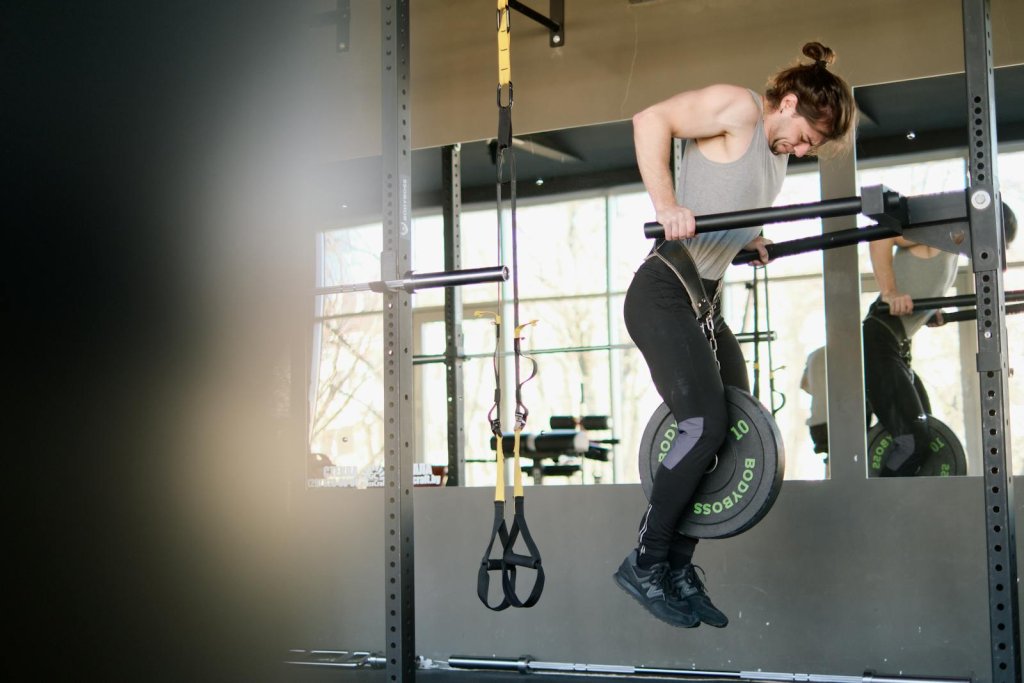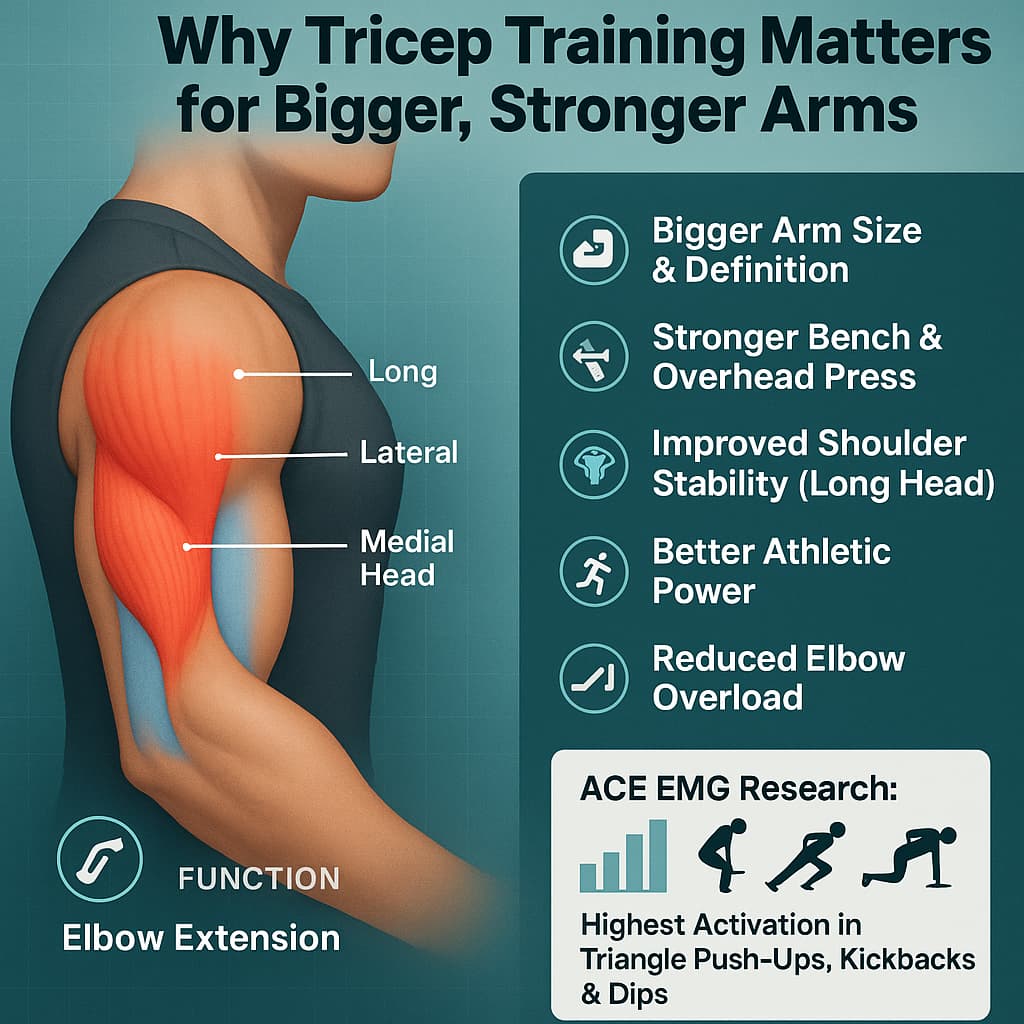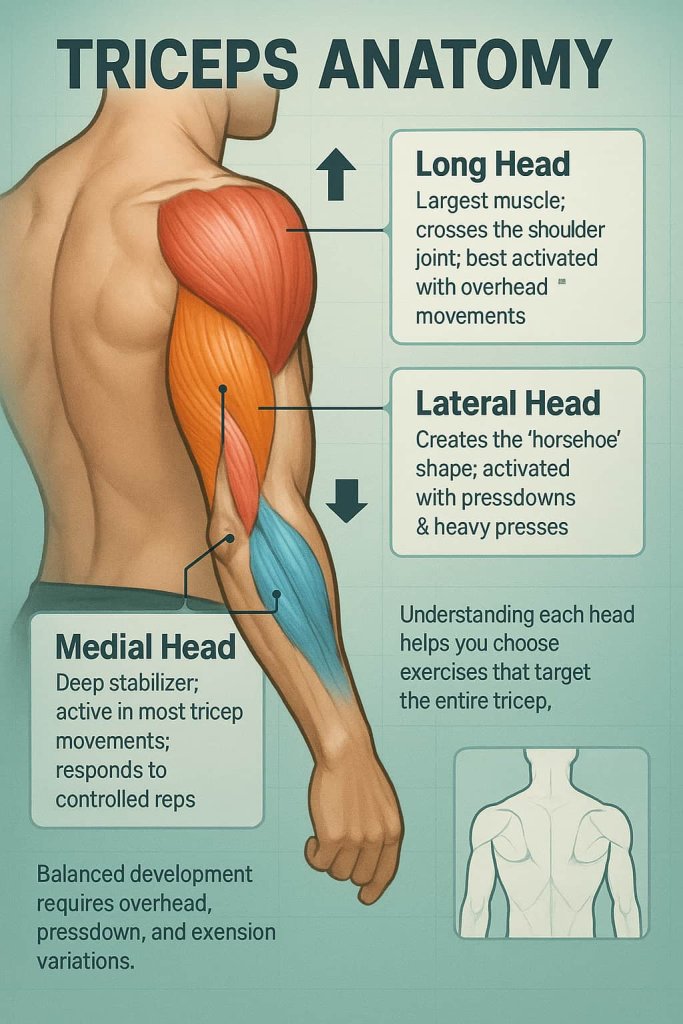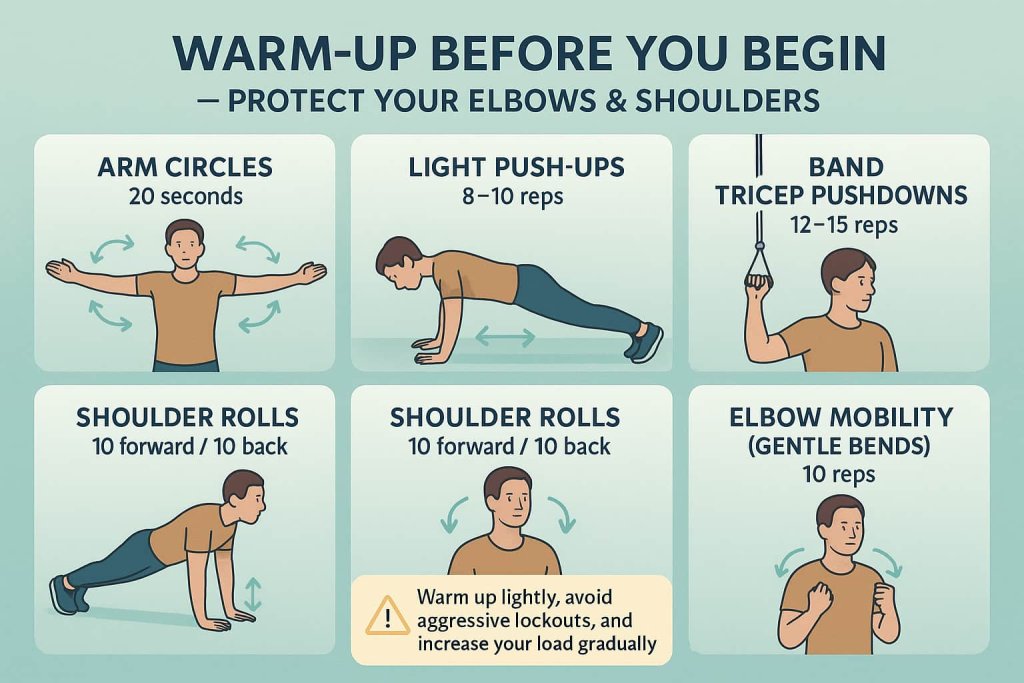If you want bigger, stronger arms fast, training your triceps is the most effective way to do it. The triceps make up nearly two-thirds of your upper-arm size, so targeting them directly leads to faster growth, more definition, and stronger pressing performance.

Understanding which exercises activate the long, lateral, and medial heads of the triceps will help you grow balanced, powerful arms. This guide covers the 20 best tricep exercises, including bodyweight, dumbbell, barbell, and cable variations—supported by recent strength-training research and official fitness guidelines.
Why Tricep Training Matters for Bigger, Stronger Arms
Your triceps are responsible for elbow extension and play a major role in all pushing movements—bench press, overhead press, dips, and push-ups. They also create the “horseshoe” arm shape lifters want.

Key reasons tricep training matters:
- Enhances upper-arm size and definition
- Increases strength in benching and overhead pressing
- Supports shoulder stability (long head)
- Improves athletic power in throwing and pushing
- Helps prevent elbow overload by strengthening surrounding muscles
Research from the American Council on Exercise (ACE) demonstrates that certain tricep exercises—like triangle push-ups, kickbacks, and dips—produce significantly higher muscle activation than others. Consistently training the triceps with a variety of angles leads to faster growth and measurable strength improvements.
Triceps Anatomy

Understanding triceps anatomy helps you choose exercises that hit every head:
Long Head
- Largest of the three
- Crosses the shoulder joint
- Best activated with overhead movements
Lateral Head
- Creates most of the visible “horseshoe” shape
- Best activated through pressdowns and heavy compound work
Medial Head
- Deep stabilizer
- Active in nearly all tricep movements
- Responds well to lighter, controlled reps
A complete routine should include angles that target all three heads for balanced development.
Warm-Up Before You Begin

Warming up protects your elbows and shoulders while improving extension strength.
Quick Warm-Up Routine (3–5 Minutes)
- Arm circles – 20 seconds
- Light push-ups – 8–10 reps
- Band tricep pushdowns – 12–15 reps
- Shoulder rolls – 10 forward / 10 back
- Elbow mobility (gentle bends) – 10 reps
Trainer Tip: Warm up lightly, avoid locking out aggressively, and increase the load gradually.
20 Best Tricep Exercises (Beginner to Advanced)
Below are the top exercises, including variations that prioritize each head. Use a mix of them weekly for optimal results.
1. Triangle (Diamond) Push-Up
Why it works:
This variation forces your elbows to stay close to your ribcage, which dramatically increases triceps activation. ACE-sponsored EMG testing shows it produces some of the highest tricep activation of any bodyweight exercise.
Muscles worked:
All three tricep heads, with strong emphasis on the medial and lateral heads.
How to do it:
- Place your hands together under your chest, forming a diamond shape with thumbs and index fingers.
- Keep your elbows tight and body straight.
- Lower your chest toward your hands, pause briefly, then press back up.
Trainer Tip:
Shift your chest slightly forward over your hands to reduce wrist pressure and improve push-up alignment.
2. Bench Dips
Why it works:
Bench dips allow deep elbow flexion, increasing tension on the triceps when done with controlled range.
Muscles worked:
Lateral and long head of the triceps.
How to do it:
- Sit on a bench, place hands beside hips, and extend legs forward.
- Slide your hips off the bench and lower yourself until elbows reach about 90 degrees.
- Press back up without locking out aggressively.
Trainer Tip:
Avoid dipping too low—going beyond shoulder height increases anterior shoulder strain.
3. Parallel Bar Dips
Why it works:
Supports heavy loading and deep elbow extension, making it one of the best compound tricep builders.
Muscles worked:
All tricep heads, with additional chest activation.
How to do it:
- Grip parallel bars and lift your body.
- Keep elbows tucked as you lower yourself under control.
- Press back up without flaring elbows.
Trainer Tip:
If shoulder discomfort occurs, slightly reduce depth or switch to bench dips.
4. Close-Grip Bench Press
Why it works:
The narrow grip places more demand on the triceps instead of the chest, making it ideal for strength and mass.
Muscles worked:
Medial and lateral tricep heads.
How to do it:
- Lie on a bench with hands shoulder-width apart.
- Lower the bar to your sternum with elbows close.
- Press upward with controlled lockout.
Trainer Tip:
Don’t use an excessively narrow grip—a shoulder-width grip protects wrists and elbows.
5. Skull Crushers (EZ-Bar or Dumbbell)
Why it works:
The long head gets a deep stretch, promoting muscular tension and hypertrophy.
Muscles worked:
Long and lateral tricep heads.
How to do it:
- Lie flat and hold an EZ bar or dumbbells overhead.
- Lower the weight to your forehead or slightly behind your head.
- Extend arms upward without letting elbows flare.
Trainer Tip:
Keep elbows slightly tucked to minimize elbow stress.
6. Overhead Dumbbell Extension
Why it works:
Moves the arm overhead, placing the long head in a maximally stretched position for deep activation.
Muscles worked:
Primarily the long head.
How to do it:
- Hold a dumbbell overhead with both hands.
- Lower it behind your head, keeping elbows pointed forward.
- Extend fully without arching your back.
Trainer Tip:
Keep your ribs down and core braced to prevent lower-back arching.
7. Rope Tricep Pressdown
Why it works:
Allows full arm extension and wrist separation at the bottom, increasing contraction.
Muscles worked:
Lateral and medial heads.
How to do it:
- Set a rope attachment at a high pulley.
- Press downward and pull rope ends apart at the bottom.
- Return with elbows fixed in position.
Trainer Tip:
Lean forward slightly to isolate the triceps more effectively.
8. Straight-Bar Pressdown
Why it works:
Provides more stability than the rope, allowing heavier loading.
Muscles worked:
Primarily the lateral head.
How to do it:
- Use a straight bar attached to a high pulley.
- Press down while keeping elbows close to your sides.
- Finish with the bar near your hips.
Trainer Tip:
Avoid letting shoulders elevate—keep shoulder blades down and tight.
9. Cable Overhead Tricep Extension
Why it works:
Creates continuous cable tension, especially in the stretched position.
Muscles worked:
Long head.
How to do it:
- Attach rope to a low pulley.
- Face away from the machine and extend arms overhead.
- Lower behind your head, then press upward.
Trainer Tip:
Keep elbows pointed forward to avoid letting shoulders flare.
10. Dumbbell Kickback
Why it works:
One of the highest-activation tricep exercises according to ACE, due to high tension at full lockout.
Muscles worked:
Lateral head focus.
How to do it:
- Hinge forward with a flat back.
- Hold a dumbbell and extend your arm behind you.
- Lock out fully with controlled contraction.
Trainer Tip:
Use light weight and prioritize perfect form and full extension.
11. Cable Kickback
Why it works:
Smooth cable resistance enhances the lockout phase more effectively than dumbbells.
Muscles worked:
Lateral and medial heads.
How to do it:
- Attach a single handle to a low pulley.
- Lean forward slightly and extend the working arm backward.
- Keep your upper arm stationary.
Trainer Tip:
Avoid swinging—move only the forearm.
12. JM Press
Why it works:
Combines tricep isolation with strength-building mechanics from the bench press.
Muscles worked:
Lateral head + chest/shoulder stabilizers.
How to do it:
- Lie on a bench with an EZ bar.
- Lower the bar toward your upper chest while keeping elbows tucked.
- Press upward without turning it into a standard bench press.
Trainer Tip:
Start with very light weight; positioning takes practice.
13. Close-Grip Push-Up
Why it works:
Provides strong tricep engagement with minimal equipment; great for beginners.
Muscles worked:
All tricep heads.
How to do it:
- Place hands shoulder-width apart.
- Keep elbows close and body straight.
- Lower and press up with controlled form.
Trainer Tip:
Use a bench or elevated surface to reduce difficulty if needed.
14. Seated Overhead EZ-Bar Extension
Why it works:
Provides a stable platform for targeting the long head with heavier loads.
Muscles worked:
Long head.
How to do it:
- Sit upright and hold an EZ bar overhead.
- Lower bar behind your head, keeping elbows fixed.
- Extend fully.
Trainer Tip:
Keep wrists neutral to prevent strain.
15. Cable Skull Crushers
Why it works:
Cable tension reduces joint stress while maintaining resistance throughout the movement.
Muscles worked:
All three heads.
How to do it:
- Attach an EZ bar to a low pulley.
- Lie on a bench or on the floor.
- Lower bar toward your forehead and extend back up.
Trainer Tip:
Keep shoulders steady—avoid moving the upper arms.
16. One-Arm Dumbbell Overhead Extension
Why it works:
Emphasizes long-head recruitment and helps correct side-to-side imbalances.
Muscles worked:
Long head.
How to do it:
- Raise a dumbbell overhead with one hand.
- Lower behind your head, keeping elbow stable.
- Extend with slow, controlled motion.
Trainer Tip:
Use a slow tempo, especially in the bottom stretch.
17. Reverse-Grip Pressdown
Why it works:
The underhand grip shifts activation toward the medial head, a commonly under-targeted area.
Muscles worked:
Medial head.
How to do it:
- Use an underhand grip on a straight bar.
- Press straight down while keeping elbows tight.
- Pause briefly at the bottom.
Trainer Tip:
Maintain wrist alignment—don’t curl the bar.
18. Tate Press
Why it works:
This unique movement combines elbow extension with inward pressing, heavily stressing the lateral head.
Muscles worked:
Lateral and medial heads.
How to do it:
- Lie on a bench holding dumbbells over your chest.
- Bend elbows outward and lower dumbbells toward your chest.
- Press the dumbbells up and inward.
Trainer Tip:
Start lighter than usual—this exercise is technique-dependent.
19. Single-Arm Cable Pressdown
Why it works:
Improves unilateral strength and helps correct muscle imbalances.
Muscles worked:
Lateral and medial heads.
How to do it:
- Stand sideways to the pulley.
- Grip the handle with one hand and press downward.
- Pause briefly at full extension.
Trainer Tip:
Slightly rotate wrist outward at the bottom to enhance contraction.
20. Weighted Dips
Why it works:
Allows maximum progressive overload, making it a top-tier mass builder for advanced lifters.
Muscles worked:
All tricep heads, especially lateral and long head.
How to do it:
- Put on a dip belt and secure added weight.
- Perform dips with elbows close and controlled depth.
- Press up strongly without overextending.
Trainer Tip:
Don’t add weight until you can perform 12–15 clean bodyweight reps.
Common Tricep Training Mistakes
Avoid these for better growth:
- Flaring elbows too wide
- Rushing lockout without squeeze
- Using momentum instead of control
- Going too heavy on isolation lifts
- Overusing dips if you have shoulder issues
- Not including overhead work (long head neglect)
Sample Tricep Workout (Beginner, Intermediate & Advanced)
Beginner
- Close-Grip Push-Up – 3×10
- Rope Pressdown – 3×12
- Overhead Dumbbell Extension – 2×12
Intermediate
- Close-Grip Bench Press – 4×8
- Skull Crushers – 3×10
- Cable Overhead Extension – 3×12
- Kickbacks – 2×12
Advanced
- Weighted Dips – 4×6
- JM Press – 3×8
- Cable Skull Crushers – 3×12
- Rope Pressdown (drop set) – 2 sets
Safety Tips
- Stop if you feel sharp elbow or shoulder pain
- Avoid overextending elbows
- Warm up properly before heavy pressing
- Start lighter on skull crushers and overhead movements
- Rest 48 hours between intense tricep sessions
FAQs
1. How many times a week should I train triceps?
2–3 times per week is ideal for muscle growth.
2. Which tricep exercise builds size the fastest?
Weighted dips, close-grip bench press, and overhead extensions (long head) offer the most growth potential.
3. Are dips bad for the shoulders?
They can be if taken too deep. Use shallow dips or replace with close-grip push-ups if needed.
4. How many sets should I do per week?
Aim for 6–12 total tricep sets per week, depending on your experience.
5. Dumbbells or cables—which is better for triceps?
Both. Dumbbells offer free-weight stability; cables provide continuous tension.
6. Do tricep exercises reduce arm fat?
No exercise spot-reduces fat. They help build muscle, which shapes the arms.
7. Should I lock out my elbows?
Controlled lockout is fine; avoid snapping or hyperextending.
Conclusion
Training your triceps properly is the fastest way to build bigger, stronger, more defined arms. By using a mix of bodyweight, dumbbell, barbell, and cable exercises, you’ll activate all three heads of the triceps and unlock maximum muscle growth.
Start with proper warm-ups, use controlled form, and train consistently.
Ready to build stronger arms? Start incorporating these 20 proven tricep exercises into your weekly routine today.
References
- Schoenfeld BJ, Ogborn D, Krieger JW (2016). Effects of Resistance Training Frequency on Measures of Muscle Hypertrophy: A Systematic Review and Meta-Analysis. Sports Medicine, 46(11), 1689–1697.
https://pubmed.ncbi.nlm.nih.gov/27102172/ - American College of Sports Medicine (ACSM) Position Stand (2009). Progression Models in Resistance Training for Healthy Adults. Medicine & Science in Sports & Exercise, 41(3), 687–708.
https://pubmed.ncbi.nlm.nih.gov/19204579/ - Bernárdez-Vázquez R et al. (2022). Resistance Training Variables for Optimization of Muscle Hypertrophy: An Umbrella Review. Frontiers in Sports and Active Living.
https://www.frontiersin.org/articles/10.3389/fspor.2022.949021 - ACSM – Resistance Training for Health and Fitness (Public Guideline PDF).
https://www.prescriptiontogetactive.com/static/pdfs/resistance-training-ACSM.pdf - Paluch AE et al. (2024). Resistance Exercise Training in Individuals With and Without Cardiovascular Disease. Circulation.
https://www.ahajournals.org/doi/10.1161/CIR.0000000000001189 - ACE / Sample EMG – Triceps Brachii During Different Exercises. High-activation findings for diamond push-ups, dips, and kickbacks.
https://www.krigolsonteaching.com/uploads/4/3/8/4/43848243/sampleemg-triceps.pdf - Marcolin G et al. (2015). Selective Activation of Shoulder, Trunk, and Arm Muscles in Push-Up Variants. Journal of Strength and Conditioning Research.
https://www.ncbi.nlm.nih.gov/pmc/articles/PMC4732391/
